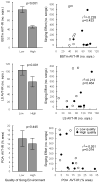Song environment affects singing effort and vasotocin immunoreactivity in the forebrain of male Lincoln's sparrows
- PMID: 20399213
- PMCID: PMC2916047
- DOI: 10.1016/j.yhbeh.2010.04.002
Song environment affects singing effort and vasotocin immunoreactivity in the forebrain of male Lincoln's sparrows
Abstract
Male songbirds often establish territories and attract mates by singing, and some song features can reflect the singer's condition or quality. The quality of the song environment can change, so male songbirds should benefit from assessing the competitiveness of the song environment and appropriately adjusting their own singing behavior and the neural substrates by which song is controlled. In a wide range of taxa, social modulation of behavior is partly mediated by the arginine vasopressin or vasotocin (AVP/AVT) systems. To examine the modulation of singing behavior in response to the quality of the song environment, we compared the song output of laboratory-housed male Lincoln's sparrows (Melospiza lincolnii) exposed to 1 week of chronic playback of songs categorized as either high or low quality, based on song length, complexity, and trill performance. To explore the neural basis of any facultative shifts in behavior, we also quantified the subjects' AVT immunoreactivity (AVT-IR) in three forebrain regions that regulate sociosexual behavior: the medial bed nucleus of the stria terminalis (BSTm), the lateral septum (LS), and the preoptic area. We found that high-quality songs increased singing effort and reduced AVT-IR in the BSTm and LS, relative to low-quality songs. The effect of the quality of the song environment on both singing effort and forebrain AVT-IR raises the hypothesis that AVT within these brain regions plays a role in the modulation of behavior in response to competition that individual males may assess from the prevailing song environment.
Copyright 2010 Elsevier Inc. All rights reserved.
Figures




Similar articles
-
Song competition affects monoamine levels in sensory and motor forebrain regions of male Lincoln's sparrows (Melospiza lincolnii).PLoS One. 2013;8(3):e59857. doi: 10.1371/journal.pone.0059857. Epub 2013 Mar 26. PLoS One. 2013. PMID: 23555809 Free PMC article.
-
Neural responses to territorial challenge and nonsocial stress in male song sparrows: segregation, integration, and modulation by a vasopressin V1 antagonist.Horm Behav. 2004 Nov;46(4):371-81. doi: 10.1016/j.yhbeh.2004.02.008. Horm Behav. 2004. PMID: 15465522
-
Urban and rural male song sparrows (Melospiza melodia) differ in territorial aggression and activation of vasotocin neurons in response to song challenge.Horm Behav. 2023 Nov;156:105438. doi: 10.1016/j.yhbeh.2023.105438. Epub 2023 Oct 4. Horm Behav. 2023. PMID: 37801916
-
How Song Experience Affects Female Mate-Choice, Male Song, and Monoaminergic Activity in the Auditory Telencephalon in Lincoln's Sparrows.Integr Comp Biol. 2017 Oct 1;57(4):891-901. doi: 10.1093/icb/icx080. Integr Comp Biol. 2017. PMID: 28992115 Review.
-
Behavioral neuroendocrinology of vasotocin and vasopressin and the sensorimotor processing hypothesis.Front Neuroendocrinol. 2002 Oct;23(4):317-41. doi: 10.1016/s0091-3022(02)00004-3. Front Neuroendocrinol. 2002. PMID: 12381329 Review.
Cited by
-
Plumage coloration and social context influence male investment in song.Biol Lett. 2018 Jul;14(7):20180300. doi: 10.1098/rsbl.2018.0300. Biol Lett. 2018. PMID: 30021863 Free PMC article.
-
Patterns of phosphorylated tyrosine hydroxylase vary with song production in female starlings.Brain Res. 2013 Mar 1;1498:41-9. doi: 10.1016/j.brainres.2012.12.020. Epub 2012 Dec 25. Brain Res. 2013. PMID: 23270608 Free PMC article.
-
Sex differences in auditory brainstem response audiograms from vasopressin-deficient Brattleboro and wild-type Long-Evans rats.PLoS One. 2019 Aug 30;14(8):e0222096. doi: 10.1371/journal.pone.0222096. eCollection 2019. PLoS One. 2019. PMID: 31469871 Free PMC article.
-
Vasopressin Proves Es-sense-tial: Vasopressin and the Modulation of Sensory Processing in Mammals.Front Endocrinol (Lausanne). 2015 Feb 5;6:5. doi: 10.3389/fendo.2015.00005. eCollection 2015. Front Endocrinol (Lausanne). 2015. PMID: 25705203 Free PMC article. Review.
-
Physically challenging song traits, male quality, and reproductive success in house wrens.PLoS One. 2013;8(3):e59208. doi: 10.1371/journal.pone.0059208. Epub 2013 Mar 19. PLoS One. 2013. PMID: 23527137 Free PMC article.
References
-
- Alatalo RV, Glynn C, Lundberg A. Singing rate and female attraction in the pied flycatcher - an experiment. Anim Behav. 1990;39:601–603.
-
- Ball GF, Auger CJ, Bernard DJ, Charlier TD, Sartor JJ, Riters LV, Balthazart J. Seasonal plasticity in the song control system: multiple brain sites of steroid hormone action and the importance of variation in song behavior. Ann NY Acad Sci. 2004;1016:586–610. - PubMed
-
- Ball GF, Castelino CB, Maney DL, Appeltants D, Balthazart J. The activation of birdsong by testosterone. Ann NY Acad Sci. 2003;1007:211–231. - PubMed
-
- Ballentine B. Morphological adaptation influences the evolution of a mating signal. Evolution. 2006;60:1936–1944. - PubMed
Publication types
MeSH terms
Substances
Grants and funding
LinkOut - more resources
Full Text Sources
Miscellaneous

